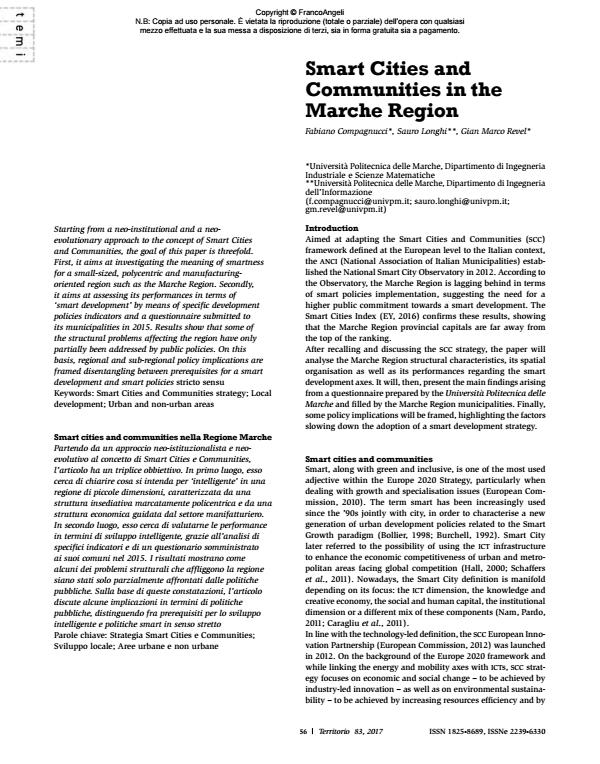Smart Cities and Communities in the Marche Region
Titolo Rivista TERRITORIO
Autori/Curatori Fabiano Compagnucci, Sauro Longhi, Gian Marco Revel
Anno di pubblicazione 2018 Fascicolo 2017/83
Lingua Inglese Numero pagine 6 P. 56-61 Dimensione file 245 KB
DOI 10.3280/TR2017-083007
Il DOI è il codice a barre della proprietà intellettuale: per saperne di più
clicca qui
Qui sotto puoi vedere in anteprima la prima pagina di questo articolo.
Se questo articolo ti interessa, lo puoi acquistare (e scaricare in formato pdf) seguendo le facili indicazioni per acquistare il download credit. Acquista Download Credits per scaricare questo Articolo in formato PDF

FrancoAngeli è membro della Publishers International Linking Association, Inc (PILA)associazione indipendente e non profit per facilitare (attraverso i servizi tecnologici implementati da CrossRef.org) l’accesso degli studiosi ai contenuti digitali nelle pubblicazioni professionali e scientifiche
Starting from a neo-institutional and a neoevolutionary approach to the concept of Smart Cities and Communities, the goal of this paper is threefold. First, it aims at investigating the meaning of smartness for a small-sized, polycentric and manufacturingoriented region such as the Marche Region. Secondly, it aims at assessing its performances in terms of ‘smart development’ by means of specific development policies indicators and a questionnaire submitted to its municipalities in 2015. Results show that some of the structural problems affecting the region have only partially been addressed by public policies. On this basis, regional and sub-regional policy implications are framed disentangling between prerequisites for a smart development and smart policies stricto sensu
Partendo da un approccio neo-istituzionalista e neoevolutivo al concetto di Smart Cities e Communities, l’articolo ha un triplice obbiettivo. In primo luogo, esso cerca di chiarire cosa si intenda per ‘intelligente’ in una regione di piccole dimensioni, caratterizzata da una struttura insediativa marcatamente policentrica e da una struttura economica guidata dal settore manifatturiero. In secondo luogo, esso cerca di valutarne le performance in termini di sviluppo intelligente, grazie all’analisi di specifici indicatori e di un questionario somministrato ai suoi comuni nel 2015. I risultati mostrano come alcuni dei problemi strutturali che affliggono la regione siano stati solo parzialmente affrontati dalle politiche pubbliche. Sulla base di queste constatazioni, l’articolo discute alcune implicazioni in termini di politiche pubbliche, distinguendo fra prerequisiti per lo sviluppo intelligente e politiche smart in senso stretto
Parole chiave:Strategia Smart Cities e Communities; Sviluppo locale; Aree urbane e non urban
Fabiano Compagnucci, Sauro Longhi, Gian Marco Revel, Smart Cities and Communities in the Marche Region in "TERRITORIO" 83/2017, pp 56-61, DOI: 10.3280/TR2017-083007